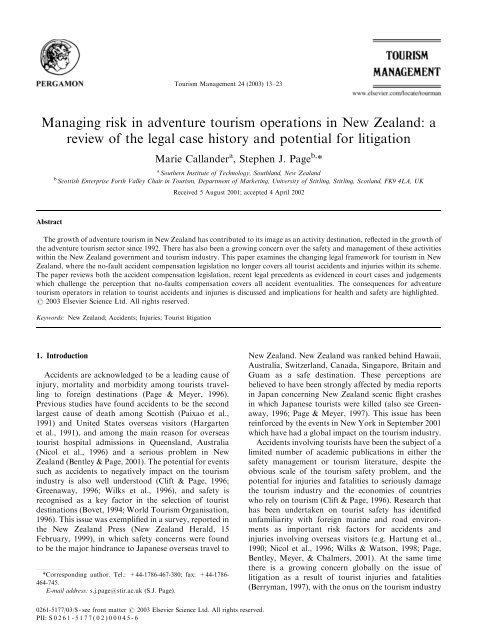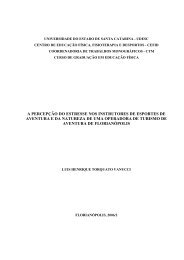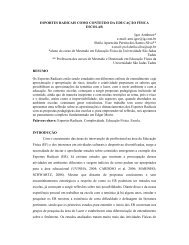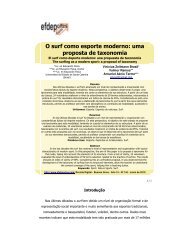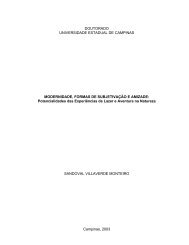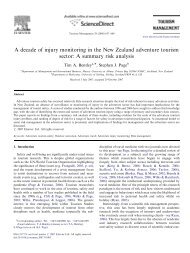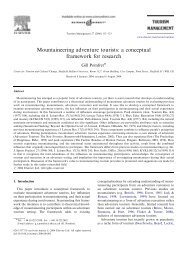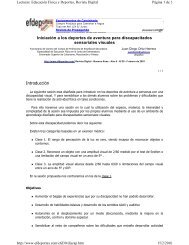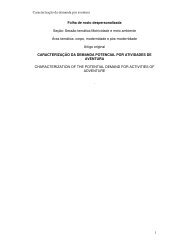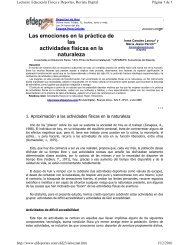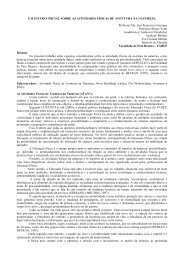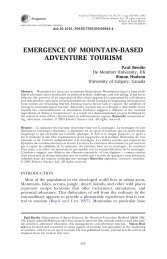Managing risk in adventure tourism operations in New Zealand: a ...
Managing risk in adventure tourism operations in New Zealand: a ...
Managing risk in adventure tourism operations in New Zealand: a ...
Create successful ePaper yourself
Turn your PDF publications into a flip-book with our unique Google optimized e-Paper software.
Tourism Management 24 (2003) 13–23<br />
<strong>Manag<strong>in</strong>g</strong> <strong>risk</strong> <strong>in</strong> <strong>adventure</strong> <strong>tourism</strong> <strong>operations</strong> <strong>in</strong> <strong>New</strong> <strong>Zealand</strong>: a<br />
review of the legal case history and potential for litigation<br />
Marie Callander a , Stephen J. Page b, *<br />
a Southern Institute of Technology, Southland, <strong>New</strong> <strong>Zealand</strong><br />
b Scottish Enterprise Forth Valley Chair <strong>in</strong> Tourism, Department of Market<strong>in</strong>g, University of Stirl<strong>in</strong>g, Stirl<strong>in</strong>g, Scotland, FK9 4LA, UK<br />
Received 5 August 2001; accepted 4 April 2002<br />
Abstract<br />
The growth of <strong>adventure</strong> <strong>tourism</strong> <strong>in</strong> <strong>New</strong> <strong>Zealand</strong> has contributed to its image as an activity dest<strong>in</strong>ation, reflected <strong>in</strong> the growth of<br />
the <strong>adventure</strong> <strong>tourism</strong> sector s<strong>in</strong>ce 1992. There has also been a grow<strong>in</strong>g concern over the safety and management of these activities<br />
with<strong>in</strong> the <strong>New</strong> <strong>Zealand</strong> government and <strong>tourism</strong> <strong>in</strong>dustry. This paper exam<strong>in</strong>es the chang<strong>in</strong>g legal framework for <strong>tourism</strong> <strong>in</strong> <strong>New</strong><br />
<strong>Zealand</strong>, where the no-fault accident compensation legislation no longer covers all tourist accidents and <strong>in</strong>juries with<strong>in</strong> its scheme.<br />
The paper reviews both the accident compensation legislation, recent legal precedents as evidenced <strong>in</strong> court cases and judgements<br />
which challenge the perception that no-faults compensation covers all accident eventualities. The consequences for <strong>adventure</strong><br />
<strong>tourism</strong> operators <strong>in</strong> relation to tourist accidents and <strong>in</strong>juries is discussed and implications for health and safety are highlighted.<br />
r 2003 Elsevier Science Ltd. All rights reserved.<br />
Keywords: <strong>New</strong> <strong>Zealand</strong>; Accidents; Injuries; Tourist litigation<br />
1. Introduction<br />
Accidents are acknowledged to be a lead<strong>in</strong>g cause of<br />
<strong>in</strong>jury, mortality and morbidity among tourists travell<strong>in</strong>g<br />
to foreign dest<strong>in</strong>ations (Page & Meyer, 1996).<br />
Previous studies have found accidents to be the second<br />
largest cause of deathamong Scottish(Paixao et al.,<br />
1991) and United States overseas visitors (Hargarten<br />
et al., 1991), and among the ma<strong>in</strong> reason for overseas<br />
tourist hospital admissions <strong>in</strong> Queensland, Australia<br />
(Nicol et al., 1996) and a serious problem <strong>in</strong> <strong>New</strong><br />
<strong>Zealand</strong> (Bentley & Page, 2001). The potential for events<br />
suchas accidents to negatively impact on the <strong>tourism</strong><br />
<strong>in</strong>dustry is also well understood (Clift & Page, 1996;<br />
Greenaway, 1996; Wilks et al., 1996), and safety is<br />
recognised as a key factor <strong>in</strong> the selection of tourist<br />
dest<strong>in</strong>ations (Bovet, 1994; World Tourism Organisation,<br />
1996). This issue was exemplified <strong>in</strong> a survey, reported <strong>in</strong><br />
the <strong>New</strong> <strong>Zealand</strong> Press (<strong>New</strong> <strong>Zealand</strong> Herald, 15<br />
February, 1999), <strong>in</strong> which safety concerns were found<br />
to be the major h<strong>in</strong>drance to Japanese overseas travel to<br />
*Correspond<strong>in</strong>g author. Tel.: +44-1786-467-380; fax: +44-1786-<br />
464-745.<br />
E-mail address: s.j.page@stir.ac.uk (S.J. Page).<br />
<strong>New</strong> <strong>Zealand</strong>. <strong>New</strong> <strong>Zealand</strong> was ranked beh<strong>in</strong>d Hawaii,<br />
Australia, Switzerland, Canada, S<strong>in</strong>gapore, Brita<strong>in</strong> and<br />
Guam as a safe dest<strong>in</strong>ation. These perceptions are<br />
believed to have been strongly affected by media reports<br />
<strong>in</strong> Japan concern<strong>in</strong>g <strong>New</strong> <strong>Zealand</strong> scenic flight crashes<br />
<strong>in</strong> which Japanese tourists were killed (also see Greenaway,<br />
1996; Page & Meyer, 1997). This issue has been<br />
re<strong>in</strong>forced by the events <strong>in</strong> <strong>New</strong> York <strong>in</strong> September 2001<br />
which have had a global impact on the <strong>tourism</strong> <strong>in</strong>dustry.<br />
Accidents <strong>in</strong>volv<strong>in</strong>g tourists have been the subject of a<br />
limited number of academic publications <strong>in</strong> either the<br />
safety management or <strong>tourism</strong> literature, despite the<br />
obvious scale of the <strong>tourism</strong> safety problem, and the<br />
potential for <strong>in</strong>juries and fatalities to seriously damage<br />
the <strong>tourism</strong> <strong>in</strong>dustry and the economies of countries<br />
who rely on <strong>tourism</strong> (Clift & Page, 1996). Research that<br />
has been undertaken on tourist safety has identified<br />
unfamiliarity withforeign mar<strong>in</strong>e and road environments<br />
as important <strong>risk</strong> factors for accidents and<br />
<strong>in</strong>juries <strong>in</strong>volv<strong>in</strong>g overseas visitors (e.g. Hartung et al.,<br />
1990; Nicol et al., 1996; Wilks & Watson, 1998; Page,<br />
Bentley, Meyer, & Chalmers, 2001). At the same time<br />
there is a grow<strong>in</strong>g concern globally on the issue of<br />
litigation as a result of tourist <strong>in</strong>juries and fatalities<br />
(Berryman, 1997), with the onus on the <strong>tourism</strong> <strong>in</strong>dustry<br />
0261-5177/03/$ - see front matter r 2003 Elsevier Science Ltd. All rights reserved.<br />
PII: S 0261-5177(02)00045-6
14<br />
M. Callander, S.J. Page / Tourism Management 24 (2003) 13–23<br />
to provide a safe environment and to ensure all<br />
necessary precautions are taken to ensure tourist well<br />
be<strong>in</strong>g is assured (Bentley & Page, 2001).<br />
This paper exam<strong>in</strong>es the expand<strong>in</strong>g <strong>in</strong>terest <strong>in</strong> the<br />
legal implications of tourist safety and litigation <strong>in</strong><br />
relation to the grow<strong>in</strong>g <strong>adventure</strong> <strong>tourism</strong> <strong>in</strong>dustry <strong>in</strong><br />
<strong>New</strong> <strong>Zealand</strong>. <strong>New</strong> <strong>Zealand</strong> is an <strong>in</strong>terest<strong>in</strong>g context to<br />
exam<strong>in</strong>e, s<strong>in</strong>ce previous research(e.g. Page & Meyer,<br />
1996; Bentley & Page, 2001) highlighted the no-fault<br />
legislation provided <strong>in</strong> <strong>New</strong> <strong>Zealand</strong> which has recently<br />
seen a range of conditions where personal <strong>in</strong>jury claims<br />
may now be valid. The paper commences with a brief<br />
review of the <strong>adventure</strong> <strong>tourism</strong> sector <strong>in</strong> <strong>New</strong> <strong>Zealand</strong>,<br />
and the significance of the Accident Rehabilitation and<br />
Compensation Insurance Act (1992). The recent legal<br />
cases <strong>in</strong> <strong>New</strong> <strong>Zealand</strong> that illustrate the potential for<br />
personal <strong>in</strong>jury litigation are then discussed and the<br />
implications for the <strong>tourism</strong> sector are then reviewed.<br />
2. The <strong>New</strong> <strong>Zealand</strong> <strong>adventure</strong> <strong>tourism</strong> <strong>in</strong>dustry<br />
Adventure <strong>tourism</strong> is a burgeon<strong>in</strong>g sector of the<br />
<strong>tourism</strong> <strong>in</strong>dustry <strong>in</strong>ternationally and has been a major<br />
driver of <strong>tourism</strong> activity growth<strong>in</strong> <strong>New</strong> <strong>Zealand</strong><br />
(Bentley, Page, Meyer, & Chalmers, 2001b). The<br />
<strong>adventure</strong> <strong>tourism</strong> sector encompasses a wide range of<br />
diverse activities, and may be def<strong>in</strong>ed as commercially<br />
operated activities <strong>in</strong>volv<strong>in</strong>g a comb<strong>in</strong>ation of <strong>adventure</strong><br />
and excitement pursued <strong>in</strong> an outdoor environment.<br />
Adventure <strong>tourism</strong> is also often taken to <strong>in</strong>clude more<br />
passive activities associated witheco<strong>tourism</strong> (e.g. safaris<br />
and trekk<strong>in</strong>g <strong>in</strong> difficult terra<strong>in</strong>). <strong>New</strong> <strong>Zealand</strong> is<br />
regarded as a major dest<strong>in</strong>ation for overseas visitors<br />
wish<strong>in</strong>g to participate <strong>in</strong> active <strong>adventure</strong> <strong>tourism</strong><br />
activities, and the <strong>adventure</strong> <strong>tourism</strong> <strong>in</strong>dustry has<br />
expanded <strong>in</strong> recent years as a major niche sector with<strong>in</strong><br />
<strong>New</strong> <strong>Zealand</strong>’s <strong>tourism</strong> <strong>in</strong>dustry (Berno & Moore,<br />
1996). Approximately 10% of visitors to <strong>New</strong> <strong>Zealand</strong><br />
participate <strong>in</strong> <strong>adventure</strong> <strong>tourism</strong> of some form, accord<strong>in</strong>g<br />
to the International Visitor Survey, 1992–1993 which<br />
is now around 18% of all tourist activities among an<br />
<strong>in</strong>bound visitor population of 1.5 million per annum<br />
(Page & Meyer, 1996; Bentley & Page, 2001). The most<br />
popular of these activities <strong>in</strong>clude scenic flights, jet<br />
boat<strong>in</strong>g, white water raft<strong>in</strong>g, mounta<strong>in</strong> recreation and<br />
bungy jump<strong>in</strong>g and the significance of accidents and<br />
<strong>in</strong>juries with<strong>in</strong> this sector have been exam<strong>in</strong>ed from both<br />
a visitor perspective (Bentley et al., 2001b; Bentley &<br />
Page, 2001) as well as from the <strong>adventure</strong> <strong>tourism</strong><br />
operator perspective (Bentley, Page, & Laird, 2001a).<br />
Indeed, a press<strong>in</strong>g reason for open<strong>in</strong>g a wider debate on<br />
these issues is reflected <strong>in</strong> Page and Meyer’s (1996)<br />
assertion that the exist<strong>in</strong>g compensation regime <strong>in</strong> <strong>New</strong><br />
<strong>Zealand</strong> provided a culture of m<strong>in</strong>imum safety standards<br />
for <strong>adventure</strong> <strong>tourism</strong> <strong>in</strong> the absence of a direct<br />
route for litigation and damages follow<strong>in</strong>g accidents.<br />
This is important given the grow<strong>in</strong>g data with a limited<br />
number of publications on the <strong>risk</strong> factors and likely<br />
scale and impact of accidents and <strong>in</strong>juries among visitors<br />
<strong>in</strong> this sector of the <strong>tourism</strong> <strong>in</strong>dustry. This therefore<br />
raises questions as to the agencies and legislation<br />
associated with the well be<strong>in</strong>g of visitors. For this<br />
reason, attention now turns to the Accident Rehabilitation<br />
and Compensation Insurance (hereafter ACC to<br />
use its popular <strong>New</strong> <strong>Zealand</strong> acronym) legislation and<br />
the wider legislative framework pert<strong>in</strong>ent to the <strong>tourism</strong><br />
sector <strong>in</strong> <strong>New</strong> <strong>Zealand</strong>.<br />
3. The accident rehabilitation and compensation<br />
<strong>in</strong>surance legislation<br />
The ACC legislation, orig<strong>in</strong>ally formulated <strong>in</strong> 1972,<br />
was a landmark statute s<strong>in</strong>ce it established a no-fault<br />
compensation scheme for accidents, subsequently modified<br />
<strong>in</strong> 1982 and 1992 (Campbell, 1996). The Accident<br />
Rehabilitation and Compensation Act (1992) was<br />
subsequently revised <strong>in</strong> 1998 to provide a tighter<br />
def<strong>in</strong>ition of the nature of claims and extent of accident<br />
cover, due to escalat<strong>in</strong>g costs for the government agency<br />
adm<strong>in</strong>ister<strong>in</strong>g this area of welfare cover. From a <strong>tourism</strong><br />
perspective, the legislation is novel as Page and Meyer<br />
(1996) noted, s<strong>in</strong>ce it provides cover for overseas tourists<br />
on a no-fault basis dur<strong>in</strong>g their visit to <strong>New</strong> <strong>Zealand</strong>. To<br />
receive cover (i.e. the cost of treatment for an accident),<br />
visitors must see a doctor and complete the appropriate<br />
claim form. Cover for overseas tourists <strong>in</strong>clude costs of<br />
medical treatment, hospital treatment, transport expenses<br />
and some rehabilitation costs. No attempt was<br />
made by ACC to recover tourist costs from medical<br />
<strong>in</strong>surers overseas, and Page and Meyer (1996) and<br />
Bentley and Page (2001) outl<strong>in</strong>ed the costs to the <strong>New</strong><br />
<strong>Zealand</strong> taxpayer based on available data. Tourist<br />
activity <strong>in</strong> <strong>New</strong> <strong>Zealand</strong> is also subject to the conditions<br />
of the Health and Safety <strong>in</strong> Employment Act (1992)<br />
which may also establish the civil basis for action where<br />
a breachof statutory duty occurs <strong>in</strong> a <strong>tourism</strong> activity.<br />
Page (1997) also reviewed the wider responsibilities of<br />
different government departments <strong>in</strong> regulat<strong>in</strong>g and<br />
<strong>in</strong>vestigat<strong>in</strong>g accidents <strong>in</strong> the diverse <strong>adventure</strong> <strong>tourism</strong><br />
sector which spanned the Maritime Safety Authority for<br />
water based activities, the Land Transport Safety<br />
Authority for land-based activities and the Civil<br />
Aviation Authority for air-related activities (Page,<br />
1997). In this respect, activities <strong>in</strong> the <strong>adventure</strong> <strong>tourism</strong><br />
sector are subject to a variety of bodies witha concern<br />
for safety <strong>in</strong> a preventative and care context, mak<strong>in</strong>g<br />
regulation and plann<strong>in</strong>g for the entire sector difficult. It<br />
is aga<strong>in</strong>st this background that the ACC legislation is<br />
<strong>in</strong>fluential as the Accident Rehabilitation and Compensation<br />
Insurance Act 1992 (ARCIA) <strong>in</strong>troduced major
M. Callander, S.J. Page / Tourism Management 24 (2003) 13–23 15<br />
changes to the nature and extent of cover provided for<br />
victims of personal <strong>in</strong>jury by accident. The changes were<br />
so substantial both<strong>in</strong> relation to the amounts of<br />
compensation now provided and the much narrower<br />
def<strong>in</strong>itions of what is covered by the Act, that there is<br />
now a very strong <strong>in</strong>centive for those who have suffered<br />
personal <strong>in</strong>jury by accident to attempt to pursue claims<br />
for damages based on suchcauses of action as breachof<br />
contract, negligence and breachof a statutory duty. It is<br />
also evident that some significant cases that were<br />
decided under the 1972 and 1982 legislation would have<br />
had quite a different result if decided on the basis of the<br />
1992 Act, ACC vs. E [1992] 2 NZLR 426 be<strong>in</strong>g a prime<br />
example.<br />
The ARCIA excludes rights of action for damages for<br />
personal <strong>in</strong>jury under s14, subs (1):<br />
No proceed<strong>in</strong>gs for damages aris<strong>in</strong>g directly or<br />
<strong>in</strong>directly out of personal <strong>in</strong>jury covered by this Act<br />
or personal <strong>in</strong>jury by accident covered by the<br />
Accident Compensation Act 1972 or the Accident<br />
Compensation Act 1982 that is suffered by any<br />
person shall be brought <strong>in</strong> any Court <strong>in</strong> <strong>New</strong> <strong>Zealand</strong><br />
<strong>in</strong>dependently of this Act, whether by that person or<br />
any other person, and whether under any rule of law<br />
or enactment.<br />
‘‘Personal <strong>in</strong>jury covered by this Act’’ exists where the<br />
conditions set out <strong>in</strong> s8 are met. This requires that the<br />
<strong>in</strong>jury occurred <strong>in</strong> <strong>New</strong> <strong>Zealand</strong> after 1 July 1992 [subs<br />
(1)]. Under s8 (2) and (3), cover is provided for personal<br />
<strong>in</strong>jury which:<br />
(2) (a) is caused by an accident to the person<br />
concerned;<br />
(b) is caused by gradual process, disease, or<br />
<strong>in</strong>fection aris<strong>in</strong>g out of and <strong>in</strong> the course of<br />
employment as def<strong>in</strong>ed <strong>in</strong> Section 7 or Section<br />
11 of this Act; or<br />
(c) is medical mis<strong>adventure</strong> as def<strong>in</strong>ed <strong>in</strong> Section 5<br />
of this Act;<br />
(d) is a consequence of treatment for personal<br />
<strong>in</strong>jury covered by this Act<br />
(3) cover under this Act shall also extend to personal<br />
<strong>in</strong>jury that is mental or nervous shock suffered by a<br />
person as an outcome of any Act of any other<br />
person performed on, with, or <strong>in</strong> relation to the first<br />
person (but not on, with, or <strong>in</strong> relation to any other<br />
person,<br />
and Section 7(4) states:<br />
Notwithstand<strong>in</strong>g anyth<strong>in</strong>g <strong>in</strong> subsection (1) of this<br />
section, personal <strong>in</strong>jury that is related to non-physical<br />
stress shall be deemed not to have been caused by<br />
gradual process, disease, or <strong>in</strong>fection aris<strong>in</strong>g out of<br />
and <strong>in</strong> the course of employment.<br />
The ARCIA creates a bar to actions for damages for<br />
‘‘personal <strong>in</strong>jury covered by this Act’’ but does not<br />
remove the right to br<strong>in</strong>g an action for damages for<br />
personal <strong>in</strong>jury that is not ‘‘covered by this Act’’<br />
(Harrison, 1993, p. 12). The breadth of the bar to<br />
actions is aga<strong>in</strong> narrowed by the provision of detailed<br />
def<strong>in</strong>itions of the phrase ‘‘personal <strong>in</strong>jury’’ and the word<br />
‘‘accident’’, neither of which were def<strong>in</strong>ed <strong>in</strong> the<br />
previous legislation beyond specify<strong>in</strong>g various types of<br />
mishap or damage (Todd, 1997). Section 3 of the Act<br />
def<strong>in</strong>es ‘‘accident’’ as follows:<br />
(a) A specific event or series of events that <strong>in</strong>volves<br />
the application of a force or resistance external to the<br />
human body and that results <strong>in</strong> personal <strong>in</strong>jury, but<br />
does not <strong>in</strong>clude any gradual process; and the fact<br />
that a personal <strong>in</strong>jury has occurred shall not of itself<br />
be construed as an <strong>in</strong>dication or presumption that it<br />
was caused by any suchevent or series of events;<br />
In Section 4, ‘‘personal <strong>in</strong>jury’’ is also now given a<br />
detailed def<strong>in</strong>ition:<br />
(1) for the purposes of this Act, ‘‘personal <strong>in</strong>jury’’<br />
means the death of, or physical <strong>in</strong>juries to, a person,<br />
and any mental <strong>in</strong>jury suffered by that person which<br />
is an outcome of those physical <strong>in</strong>juries to that<br />
person, and has the extended mean<strong>in</strong>g assigned to it<br />
by Section 8(3) of this Act.<br />
(2) for the purposes of this Act, no cardio-vascular or<br />
cerebro-vascular episode shall be regarded as<br />
personal <strong>in</strong>jury unless:<br />
(a) it is a result of medical mis<strong>adventure</strong><br />
(b) it is a work <strong>in</strong>jury by virtue of Section 6(1) of<br />
this Act.<br />
Given these provisions, there would seem to be a<br />
number of types of personal <strong>in</strong>jury accidents that would<br />
not be covered by the ARCIA. Therefore, it is pert<strong>in</strong>ent<br />
to exam<strong>in</strong>e recent legal case histories that may now lead<br />
to <strong>adventure</strong> <strong>tourism</strong> operators be<strong>in</strong>g sued by tourists.<br />
4. Tourism and the potential for litigation for <strong>adventure</strong><br />
<strong>tourism</strong> accidents:case history evidence<br />
One <strong>in</strong>terest<strong>in</strong>g landmark case which highlighted the<br />
potential of operators fac<strong>in</strong>g actions for compensatory<br />
damages emerged on 2 November 1998 when Justice<br />
Thomas delivered the Court of Appeal’s judgement <strong>in</strong><br />
the cases of Queenstown Lakes District Council vs. Mark<br />
Thomas Palmer and Danes Shotover Rafts Limited vs.<br />
Mark Thomas Palmer Unreported CA83/98 and CA81/<br />
98. 2/11/98 (heard concurrently) where he observed:<br />
‘‘the application of the Act and the correspond<strong>in</strong>g<br />
scope for common law proceed<strong>in</strong>gs automatically<br />
adjust as and when the scope of the cover provided by
16<br />
M. Callander, S.J. Page / Tourism Management 24 (2003) 13–23<br />
the Act is extended or contracted. To the extent that<br />
the statutory cover is extended, the right to sue at<br />
common law is removed; to the extent that the cover<br />
is withdrawn or contracted, the right to sue is revived.<br />
So it is <strong>in</strong> this case’’.<br />
In this case, Mr. Palmer and his wife, while visit<strong>in</strong>g<br />
Queenstown, undertook a raft<strong>in</strong>g trip on the Shotover<br />
River withDanes Shotover Rafts, licensed by Lakes<br />
District Council. Mr. Palmer was a United States<br />
citizen. Dur<strong>in</strong>g the raft<strong>in</strong>g trip the raft encountered a<br />
rapid known as the ‘‘Toaster’’ and capsized. Mrs. Palmer<br />
was thrown <strong>in</strong>to the water where she became trapped<br />
aga<strong>in</strong>st an underwater obstruction and subsequently<br />
drowned. She was the only member of the party who did<br />
not survive. Mr. Palmer suffered no physical <strong>in</strong>juries but<br />
suffered serious mental <strong>in</strong>juries; post-traumatic stress<br />
disorder, major depressive disorder and an associated<br />
speechimpediment (see Tob<strong>in</strong>, 1992). As a result of<br />
these events Mr. Palmer commenced proceed<strong>in</strong>gs<br />
aga<strong>in</strong>st the appellants <strong>in</strong> negligence, claim<strong>in</strong>g $150,000<br />
for general damages, special damages, and exemplary<br />
damages of $50,000. Both parties accepted that the<br />
claim for exemplary damages could proceed but the<br />
<strong>in</strong>terpretation of Section 14 of the ACC Act given by<br />
Master Venn<strong>in</strong>g <strong>in</strong> Palmer vs. Danes Shotover Rafts<br />
Ltd., 3/1/97, HC Invercargill CP10/97, was that it<br />
created a bar to proceed<strong>in</strong>g withrespect to the mental<br />
<strong>in</strong>juries suffered by Mr. Palmer after witness<strong>in</strong>g his<br />
wife’s death. In light of this rul<strong>in</strong>g Mr. Palmer applied to<br />
the High Court to review the decision, at which time it<br />
was reversed by Justice Pankhurst who re<strong>in</strong>stated Mr.<br />
Palmer’s claim for compensatory damages. The appellants<br />
then appealed aga<strong>in</strong>st the decision.<br />
In deliver<strong>in</strong>g the Court’s judgement Justice Thomas<br />
considered <strong>in</strong> detail the application of Sections 14, 8(1),<br />
(2)&(3), 4(1) and 10(1)&(2). His honour stated that<br />
Section 14 must be read <strong>in</strong> conjunction withSection 8(1)<br />
and (2), not<strong>in</strong>g that the Act applies to personal <strong>in</strong>jury<br />
‘‘<strong>in</strong> respect of which there is cover under this Act’’, and<br />
that ‘‘cover under the Act is extended to personal <strong>in</strong>jury<br />
whichy.Is caused by an accident to the person<br />
concerned’’. In describ<strong>in</strong>g Mr. Palmer’s situation, it<br />
was made clear that Mr. Palmer sought damages for<br />
mental <strong>in</strong>juries suffered by himself as a result of an<br />
alleged breachof a duty of care owed to him by Danes<br />
Shotover Rafts Ltd. and the Queenstown Lakes District<br />
Council. The judge stated that Mrs. Palmer’s death ‘‘was<br />
part of a sequence of events which provides the factual<br />
basis for Mr. Palmer’s claim’’ that the defendants owed<br />
him a duty of care which had been breached and as a<br />
result he had suffered an <strong>in</strong>jury: the po<strong>in</strong>t be<strong>in</strong>g, that it<br />
was not Mrs. Palmer’s death that created the basis of her<br />
husband’s claim aga<strong>in</strong>st the defendants, but the nervous<br />
shock suffered by Mr. Palmer himself. Justice Thomas<br />
went so far <strong>in</strong> emphasis<strong>in</strong>g this po<strong>in</strong>t to say that if she<br />
had lived and Mr. Palmer had suffered the same <strong>in</strong>juries<br />
due to see<strong>in</strong>g his wife be<strong>in</strong>g thrown <strong>in</strong>to the turbulent<br />
water, his ‘‘cause of action would rema<strong>in</strong> <strong>in</strong>tact’’.<br />
Mr. Palmer was a secondary victim <strong>in</strong> relation to the<br />
death of his wife, but as his claim related to his own<br />
<strong>in</strong>juries it would seem he was viewed by the Court as a<br />
primary victim. He did not suffer an ‘‘accident’’ <strong>in</strong> terms of<br />
the def<strong>in</strong>ition <strong>in</strong> Section 2 of the Act which requires ‘‘the<br />
application of a force or resistance external to the human<br />
body and that results <strong>in</strong> personal <strong>in</strong>jury’’. There was no<br />
suchforce applied to Mr. Palmer, rather, his <strong>in</strong>juries<br />
resulted from ‘‘the trauma of personal experience’’.<br />
Justice Thomas emphasised that the legislation <strong>in</strong> all<br />
its forms ‘‘denied those persons covered under the Act<br />
access to the courts at common law <strong>in</strong> return for the<br />
perceived advantages of the statutory scheme’’, but that<br />
it did ‘‘not proscribe common law claims aris<strong>in</strong>g out of<br />
accidents’’. The purpose of Section 14 and its predecessors<br />
<strong>in</strong> the 1974 and 1982 Acts’ barr<strong>in</strong>g common law<br />
claims ‘‘is to prevent persons who suffer <strong>in</strong>jury be<strong>in</strong>g<br />
compensated twice over, once under statute and then at<br />
common law. The bar is not designed to prevent them<br />
recover<strong>in</strong>g any compensation at all’’. Justice Thomas<br />
also po<strong>in</strong>ted out that ‘‘<strong>in</strong> accordance with the traditional<br />
pr<strong>in</strong>ciple, which enjoys status <strong>in</strong> our free and democratic<br />
society, that citizens are not to be denied access to the<br />
courts, save <strong>in</strong> rare and appropriate circumstances, and<br />
then only pursuant to explicit statutory language’’,<br />
allud<strong>in</strong>g to the statement <strong>in</strong> the policy document<br />
accompany<strong>in</strong>g the 1991 budget which noted: ‘‘it may<br />
be possible that (<strong>in</strong> cases not covered by the scheme)<br />
there will be more court action than <strong>in</strong> the past’’. This<br />
<strong>in</strong>terpretation clearly suggests that Parliament recognised<br />
that claims for common law damages <strong>in</strong> relation<br />
to personal <strong>in</strong>jury were permissible where the<br />
<strong>in</strong>juries were not covered by the Act. In his conclusion<br />
Justice Thomas said that Section 14(1) did not prevent<br />
Mr. Palmer br<strong>in</strong>g<strong>in</strong>g a proceed<strong>in</strong>g at common law to<br />
recover compensatory damages for the mental <strong>in</strong>juries<br />
that he had suffered <strong>in</strong> the raft<strong>in</strong>g accident. He stated:<br />
‘‘The critical phrase <strong>in</strong> that subsection is ‘personal <strong>in</strong>jury<br />
covered by this Act’. Unless the personal <strong>in</strong>jury for<br />
which damages are sought is covered by the Act, the<br />
right to br<strong>in</strong>g proceed<strong>in</strong>gs at common law rema<strong>in</strong>s’’.<br />
Although it seems quite clear that such claims as Mr.<br />
Palmer’s may proceed, there has yet to be a case <strong>in</strong> <strong>New</strong><br />
<strong>Zealand</strong> of a similar nature where the pla<strong>in</strong>tiff has<br />
succeeded withsucha cause of action and obta<strong>in</strong>ed a<br />
judgement for compensatory damages. Cases to date,<br />
<strong>in</strong>clud<strong>in</strong>g Mr. Palmer’s, have been settled out of court so<br />
there is still not a def<strong>in</strong>itive statement on the issue with<br />
respect to the award<strong>in</strong>g of compensatory damages for<br />
personal <strong>in</strong>jury, although the right to br<strong>in</strong>g such an<br />
action is established.<br />
If it is now possible to br<strong>in</strong>g actions for common law<br />
damages for personal <strong>in</strong>juries that are not covered by
M. Callander, S.J. Page / Tourism Management 24 (2003) 13–23 17<br />
the ARCIA, it is necessary to explore to some extent, the<br />
nature of <strong>in</strong>juries that are not covered by the Act. These<br />
are <strong>in</strong>juries that may provide grounds for actions aga<strong>in</strong>st<br />
<strong>adventure</strong> <strong>tourism</strong> operators who, through their negligence,<br />
breachof contract or breachof a statutory duty<br />
become responsible for <strong>in</strong>juries to tourists, or anyone<br />
else, <strong>in</strong>jured as a result of suchnegligence.<br />
The Act quite specifically excludes certa<strong>in</strong> types of<br />
personal <strong>in</strong>jury, <strong>in</strong>clud<strong>in</strong>g personal <strong>in</strong>jury to teeththat is<br />
caused by natural use [s10(2)(b)]; non-physical stress<br />
[s7(4)]; nervous shock as a result of anyth<strong>in</strong>g other than<br />
the causes listed <strong>in</strong> the first schedule of the Act [s8(3)];<br />
<strong>in</strong>halation or <strong>in</strong>gestion of a virus, bacterium, protozoa<br />
or fungi unless it is the result of a crim<strong>in</strong>al act by<br />
another person [s3(b)]; exposure to extremes of temperature<br />
or environment for a period of more than one<br />
month, burns caused by exposure to the elements (this<br />
would appear to exclude sunburn or w<strong>in</strong>dburn from<br />
cover under the Act) [s3(c)]; the absorption of any<br />
chemical over a period of more than 1 month [s3(e)];<br />
disease caused by <strong>in</strong>fection that is not the result of<br />
crim<strong>in</strong>al conduct [s3(b)]; sk<strong>in</strong> cancer caused by long<br />
exposure to the sun [s3(c)]; personal <strong>in</strong>jury attributable<br />
to air-condition<strong>in</strong>g systems and passive smok<strong>in</strong>g [s7(3)];<br />
and cardio-vascular or cerebro-vascular episodes [s4(2)].<br />
The Act provides coverage for medical mis<strong>adventure</strong><br />
as a result of treatment by a ‘‘registered health<br />
professional’’ (Hodder & Pepperell, 2001) which would<br />
suggest that there is no coverage for medical mis<strong>adventure</strong><br />
by those who are not ‘‘registered heath professionals’’.<br />
This could <strong>in</strong>clude people such as paramedics,<br />
or a doctor or nurse who has omitted to ensure that<br />
his/her practis<strong>in</strong>g certificate is current (Harrison, 1993).<br />
This list is considerable but not exhaustive. There have<br />
been a number of cases, both<strong>in</strong> <strong>New</strong> <strong>Zealand</strong> and<br />
overseas, which provide an <strong>in</strong>dication of the likelihood<br />
of success <strong>in</strong> a proceed<strong>in</strong>g for compensatory damages <strong>in</strong><br />
relation to several of these personal <strong>in</strong>juries that are not<br />
covered by the ARCIA.<br />
An accident is def<strong>in</strong>ed as a ‘‘specific event or series of<br />
events that <strong>in</strong>volves the application of a force or<br />
resistance external to the human body and that results<br />
<strong>in</strong> personal <strong>in</strong>jury’’[ACRIA s4(2)]. In the case of ACC<br />
vs. E a 49-year-old woman, who held a senior management<br />
position <strong>in</strong> a large organisation, was sent on a<br />
management tra<strong>in</strong><strong>in</strong>g course by her employer. The<br />
course was very demand<strong>in</strong>g, and confrontational <strong>in</strong><br />
style, withparticipants work<strong>in</strong>g from 8.30 a.m. until 11<br />
p.m. E was the first female employee of the organisation<br />
to be sent on the course, and other employees <strong>in</strong>dicated<br />
to her that it would be very strenuous. On the fourth day<br />
E suffered a psychiatric breakdown and was admitted to<br />
the psychiatric unit at Well<strong>in</strong>gton Hospital. Subsequently,<br />
she suffered depressive symptoms that required<br />
treatment, and term<strong>in</strong>ated her employment for health<br />
reasons. No particular <strong>in</strong>cident dur<strong>in</strong>g the course could<br />
be identified as trigger<strong>in</strong>g the psychotic episode, but<br />
evidence confirmed that she was fit and well before<br />
go<strong>in</strong>g to the course. The management course was<br />
<strong>in</strong>strumental <strong>in</strong> her mental breakdown. As the psychotic<br />
episode occurred prior to July 1992 it was covered by the<br />
1982 Act, and it was on this basis that E had lodged a<br />
claim for compensation that was rejected by ACC. The<br />
Court of Appeal quoted from its decision <strong>in</strong> Willis vs.<br />
Attorney-General [1989] 3 NZLR 574, 577 where it stated:<br />
‘‘Personal <strong>in</strong>jury by accident’ is an <strong>in</strong>tegrated phrase,<br />
to be seen and applied as a whole and without an<br />
unnatural break<strong>in</strong>g down which would rob it of the<br />
impact it makes as a whole. Perhaps it can be called<br />
holistic, <strong>in</strong> that the sum is more than the parts’’.<br />
On the basis of this holistic <strong>in</strong>terpretation E was<br />
granted cover under the 1982 Act. The holistic <strong>in</strong>terpretation<br />
no longer applies to the phrase ‘‘personal<br />
<strong>in</strong>jury by accident’’ s<strong>in</strong>ce, both‘‘personal <strong>in</strong>jury’’ and<br />
‘‘accident’’ have been given exhaustive def<strong>in</strong>itions with<strong>in</strong><br />
the 1992 Act which lead legal commentators to believe<br />
that E would no longer be covered by the Act. She<br />
would therefore be able to sue for compensatory<br />
damages from her employer if it could be shown that<br />
the employer was negligent <strong>in</strong> send<strong>in</strong>g her on the course<br />
(Todd, 1997). It is now a popular team-build<strong>in</strong>g exercise<br />
to send staff <strong>in</strong> many sedentary occupations on courses<br />
that <strong>in</strong>volve significant amounts of challeng<strong>in</strong>g outdoor<br />
activities utilis<strong>in</strong>g the expertise of <strong>adventure</strong> <strong>tourism</strong><br />
operators to facilitate the process. If the stra<strong>in</strong> of<br />
unaccustomed fear from exposure to heights and<br />
physically demand<strong>in</strong>g activities which produces that<br />
‘‘gripped’’ feel<strong>in</strong>g on the part of the novice participant<br />
leads to a similar psychotic episode as suffered by E it<br />
seems reasonable to expect that both the employer and<br />
the facilitator of such a course may face an action for<br />
negligence on the basis that they should not have<br />
subjected a novice to sucha fearful experience.<br />
Many <strong>adventure</strong> <strong>tourism</strong> activities suchas sea<br />
kayak<strong>in</strong>g, tramp<strong>in</strong>g, mounta<strong>in</strong>eer<strong>in</strong>g and mounta<strong>in</strong><br />
bik<strong>in</strong>g, are undertaken over a period of days and<br />
<strong>in</strong>clude meals and accommodation. Food poison<strong>in</strong>g is<br />
not covered by the Act, nor was it under the 1982 Act<br />
(Todd, 1997). In ACC vs. Booth [1990] NZAR 529 a<br />
sailor, Booth, became very ill after eat<strong>in</strong>g contam<strong>in</strong>ated<br />
saveloys and sought cover under the provisions of the<br />
1982 Act. His claim was denied, as food poison<strong>in</strong>g was<br />
not regarded as ‘‘personal <strong>in</strong>jury by accident’’. In the<br />
Consumer Guarantees Act 1993, Section 6 states that<br />
goods supplied to a consumer must be of ‘‘acceptable<br />
quality’’, and <strong>in</strong> Section 7 ‘‘acceptable quality’’ is<br />
def<strong>in</strong>ed as ‘‘fit for all the purposes for which goods of<br />
the type <strong>in</strong> question are commonly supplied’’ and ‘‘safe’’<br />
(s7). Food is supplied for human consumption and must<br />
be of a quality that is suitable for such consumption. So<br />
far as implied terms are concerned, food is not treated
18<br />
M. Callander, S.J. Page / Tourism Management 24 (2003) 13–23<br />
by the law as be<strong>in</strong>g different from other goods<br />
(Halsbury’s Laws, Vol. 18, cited <strong>in</strong> Pell<strong>in</strong>g, 2000, p. 9).<br />
Bit<strong>in</strong>g <strong>in</strong>to food that results <strong>in</strong> break<strong>in</strong>g a tooth due to<br />
the presence of a foreign object with<strong>in</strong> the food,<br />
may give rise to an action aga<strong>in</strong>st the retailer or<br />
manufacturer based on the provisions of the<br />
Consumer Guarantees Act (S6,7,9, & 25). In Partner<br />
vs. ACC unreported, February 1995, Blanchard J, HC<br />
Auckland HC180/93, Partner, a food taster, endeavoured<br />
to obta<strong>in</strong> ACC cover for a broken tooth,<br />
claim<strong>in</strong>g that it was covered as the tooth broke <strong>in</strong> the<br />
course of his employment. It was not covered by the<br />
Act. The provision of meals and accommodation by an<br />
operator provides additional potential for litigation <strong>in</strong><br />
relation to personal <strong>in</strong>juries that are not covered by the<br />
ARCIA.<br />
The <strong>New</strong> <strong>Zealand</strong> bush and coastal waters, where<br />
many popular <strong>adventure</strong> <strong>tourism</strong> activities take place<br />
(Know, 1999), may give the visitor a false sense of<br />
safety. In many of <strong>New</strong> <strong>Zealand</strong>’s most prist<strong>in</strong>e<br />
recreational environments (e.g. Fiordland), the protozoa<br />
Giardia is present <strong>in</strong> rivers and lakes. Giardia causes<br />
gastroenteritis and can be very debilitat<strong>in</strong>g to the po<strong>in</strong>t<br />
of destroy<strong>in</strong>g the pleasure of a tourist’s <strong>adventure</strong> <strong>in</strong><br />
these beautiful places. Evidence from the <strong>New</strong> <strong>Zealand</strong><br />
wilderness, confirmed by ongo<strong>in</strong>g microbiological studies<br />
of giardia transmission and spread has shown that it<br />
is a grow<strong>in</strong>g problem <strong>in</strong> the bush environment,<br />
especially National Parks. The ma<strong>in</strong> causes which are<br />
attributed to its spread are the grow<strong>in</strong>g numbers of<br />
visitors to the bush environment and faecal contam<strong>in</strong>ation<br />
of water supplies. Tourist operators <strong>in</strong> these areas<br />
clearly have a duty of care to anyone under their<br />
supervision to give precise <strong>in</strong>formation about such<br />
dangers. Failure to do so could potentially give rise to<br />
actions <strong>in</strong> negligence or breachof contract under the<br />
implied terms of the Consumer Guarantees Act 1993<br />
Section 28, which requires ‘‘reasonable care and skill’’<br />
on the part of suppliers of services. The last area of<br />
significance for <strong>adventure</strong> <strong>tourism</strong> operators is the<br />
Healthand Safety <strong>in</strong> Employment Act.<br />
5. Health and safety <strong>in</strong> employment act<br />
The Health and Safety <strong>in</strong> Employment Act 1992 (HSE<br />
Act) states that it is an ‘‘Act to reform the law relat<strong>in</strong>g to<br />
the health and safety of employees, and other people at<br />
work or affected by the work of other people’’. Part II of<br />
the Act sets out the duties of employers towards their<br />
employees and others along with the duties of persons <strong>in</strong><br />
control of places of work, self-employed people pr<strong>in</strong>cipals<br />
and employees. Section 6 provides a general duty to<br />
take all practicable steps to ensure the safety of<br />
employees by provid<strong>in</strong>g a safe work<strong>in</strong>g environment.<br />
In the subsequent Sections 7–14 the duties of employers<br />
<strong>in</strong> relation to hazard management, the provision of<br />
<strong>in</strong>formation to employees and the provision of tra<strong>in</strong><strong>in</strong>g<br />
for employees, are detailed. The HSE Act provides for a<br />
variety of fairly severe penalties but does not specify the<br />
option of civil actions for breachof a statutory duty.<br />
However, historically there has always been a presumption<br />
that <strong>in</strong> <strong>in</strong>dustrial safety legislation civil actions for<br />
damages for breachof a statutory duty are allowed<br />
(Brooker’s, 2001: D1.6.07). In Culter vs. Wandsworth<br />
[1949] AC 398 (HL) (Slappendel, 1995), Lord Simmonds<br />
stated that:<br />
‘‘The only rule which <strong>in</strong> all circumstances is valid, is<br />
that the answer must depend on a consideration of<br />
the whole Act and the circumstances, <strong>in</strong>clud<strong>in</strong>g the<br />
pre-exist<strong>in</strong>g law <strong>in</strong> which it was enacted’’.<br />
And this is confirmed by the Statute Interpretation<br />
Act 1999 Section 5 which emphasises the purposive<br />
approach. The purpose of the HSE Act is set out <strong>in</strong><br />
Section 5 of the Act as follows:<br />
(1) This Act’s pr<strong>in</strong>cipal object is to provide for the<br />
prevention of harm to employees at work.<br />
Br<strong>in</strong>g<strong>in</strong>g a civil action is not <strong>in</strong>consistent withthe<br />
purpose of the HSE Act, and the imposition of damages<br />
may actually encourage employers and employees to be<br />
more careful <strong>in</strong> relation to the future management of the<br />
visitor experience. To determ<strong>in</strong>e the <strong>in</strong>tention of<br />
Parliament two tests may be applied (Todd, 1997): the<br />
class test and the alternative modes test. The class test,<br />
which has been described as the card<strong>in</strong>al test (Solomons<br />
vs. R. Gertzenste<strong>in</strong> Ltd. [1954] 2 QB 243, 256 CA), asks<br />
whether the statute was passed for the benefit of a def<strong>in</strong>ed<br />
class of persons, and if so, it is actionable by members<br />
of that class. Section 5 of the HSE Act <strong>in</strong>dicates<br />
that it is clearly focused on the prevention of harm to<br />
employees at work, and so the test would suggest<br />
that civil actions by employees are permitted.<br />
The alternative modes of enforcement test states<br />
that if the statute does not expressly provide for<br />
a remedy then a damages action is allowed. In<br />
Gard<strong>in</strong>er vs. McManus [1971] NZLR 475,481, Williams<br />
J. said ‘‘there has been a tendency <strong>in</strong> more recent<br />
years to attachless significance to the existence of<br />
a crim<strong>in</strong>al remedy’’. Add to Justice Williams’ statement<br />
the fact that <strong>in</strong>dustrial safety legislation has always<br />
been enforced by penalties but has also been a major<br />
source of civil actions (prior to 1974), it would seem<br />
likely that such actions can proceed once aga<strong>in</strong><br />
(Slappendel, 1995).<br />
When accident compensation legislation provided<br />
cover for all types of work accidents suchcivil actions<br />
were not possible, but now that there are some work<br />
<strong>in</strong>juries that are not covered (e.g. stress), br<strong>in</strong>g<strong>in</strong>g a<br />
common law action for damages for breachof a
M. Callander, S.J. Page / Tourism Management 24 (2003) 13–23 19<br />
statutory duty as laid down <strong>in</strong> the HSE Act could be<br />
possible if the pla<strong>in</strong>tiff can prove:<br />
* that the statutory duty was on the defendant;<br />
* that the duty was owed to the pla<strong>in</strong>tiff; and<br />
* that there was a breach of that duty, which caused the<br />
damage suffered by the pla<strong>in</strong>tiff (Brooker’s, 2001).<br />
The identification, elim<strong>in</strong>ation, isolation and m<strong>in</strong>imisation<br />
(Anderson, 2000) of hazards is an area of<br />
considerable concern for anyone <strong>in</strong>volved <strong>in</strong> <strong>adventure</strong><br />
<strong>tourism</strong> s<strong>in</strong>ce the hazards are an <strong>in</strong>tegral part of the<br />
<strong>adventure</strong>. Page and Meyer (1996, p. 668) observed that:<br />
‘‘Anyth<strong>in</strong>g which may <strong>in</strong>hibit the thrill, excitement, or<br />
the danger and <strong>risk</strong> of <strong>adventure</strong> <strong>tourism</strong> pursuits is<br />
currently viewed as unnecessarily burdensome and<br />
bureaucratic by this nascent <strong>in</strong>dustry sector’’. The<br />
<strong>adventure</strong> <strong>tourism</strong> market <strong>in</strong> <strong>New</strong> <strong>Zealand</strong> has generally<br />
operated with<strong>in</strong> a self-manag<strong>in</strong>g code of practice rather<br />
a mandatory set of guidel<strong>in</strong>es (Page, 1997; Tourism<br />
Policy Group, 1996). This is an area which is under<br />
review by the Tourism Industry Association and Qualmark<br />
(a jo<strong>in</strong>t venture of Tourism <strong>New</strong> <strong>Zealand</strong> and the<br />
Automobile Association) to develop a set of <strong>tourism</strong><br />
<strong>in</strong>dustry standards focuss<strong>in</strong>g of seven components:<br />
* compliance withregulatory requirements <strong>in</strong>clud<strong>in</strong>g<br />
health and safety,<br />
* service delivery,<br />
* staff tra<strong>in</strong><strong>in</strong>g,<br />
* quality facilities,<br />
* environmental management,<br />
* cultural management,<br />
* bus<strong>in</strong>ess skills and practices (Anderson, 2000).<br />
Several areas of the <strong>in</strong>dustry have developed or are<br />
develop<strong>in</strong>g their own <strong>in</strong>dustry specific standards to ‘‘bolt<br />
on’’ to the generic standards that are be<strong>in</strong>g set <strong>in</strong><br />
association withQualmark. These <strong>in</strong>clude: raft<strong>in</strong>g and<br />
jet boat<strong>in</strong>g which are also covered by the requirements<br />
of Rule 80 of the Maritime Transport Act 1994, horsetrekk<strong>in</strong>g,<br />
sea kayak<strong>in</strong>g and all-terra<strong>in</strong> vehicles. It is<br />
<strong>in</strong>tended that the standards will operate as ‘‘national<br />
best practice standards’’ which will provide an <strong>in</strong>dustry<br />
standard which may be considered <strong>in</strong> any action for<br />
negligence, breachof contract or breachof a statutory<br />
duty. Section 20 of the Health and Safety <strong>in</strong> Employment<br />
Act provides for the development of codes of<br />
practice that are a ‘‘statement of preferred work<br />
practices’’ which the M<strong>in</strong>ister may approve. This may<br />
be a way forward for these standards.<br />
One of the key motivat<strong>in</strong>g factors beh<strong>in</strong>d the<br />
development of these best practise standards, along<br />
with the clear market<strong>in</strong>g benefits, must surely be the EC<br />
Package Travel Directive which has set very high<br />
standards of consumer protection for any pre-arranged<br />
tours which <strong>in</strong>clude no fewer than two of the follow<strong>in</strong>g<br />
three elements:<br />
* transport;<br />
* accommodation; and<br />
* other tourist services not ancillary to transport or<br />
accommodation and account<strong>in</strong>g for a significant<br />
proportion of the package (see Downes, 1993).<br />
This def<strong>in</strong>ition of a travel package <strong>in</strong>cludes any prearranged<br />
comb<strong>in</strong>ation of the above travel products and<br />
<strong>in</strong>cludes bus<strong>in</strong>ess travel packages, ‘‘provided that the<br />
package is ‘sold or offered for sale <strong>in</strong> the territory of the<br />
Community’ (Downes, 1993, p. 72). There is no<br />
equivalent of the EC Package Travel Directive <strong>in</strong> <strong>New</strong><br />
<strong>Zealand</strong>, but the fact that it applies to all European<br />
visitors who book package travel <strong>in</strong>to <strong>New</strong> <strong>Zealand</strong>,<br />
means that the rights and liabilities it conta<strong>in</strong>s significantly<br />
affect <strong>New</strong> <strong>Zealand</strong> suppliers. The Directive is<br />
not a global convention but it does lead to a orient<strong>in</strong>g<br />
the duties and obligations of suppliers and tour<br />
operators to its standards that it lays down. Article 5<br />
of the Directive requires member states to make a choice<br />
of fix<strong>in</strong>g liability on either the tour operator or the travel<br />
agent (Cordato, 1994, p. 31). Whatever choice is made,<br />
should a consumer compla<strong>in</strong>, the tour operator or the<br />
travel agent will seek to recover damages from the<br />
supplier of the <strong>tourism</strong> product who failed to provide<br />
what the consumer had been led to expect by the<br />
brochures and contractual arrangements. <strong>New</strong> consumer<br />
protection laws be<strong>in</strong>g developed <strong>in</strong> Japan are also<br />
likely to impact on <strong>New</strong> <strong>Zealand</strong> operators.<br />
No cases have yet come before the courts <strong>in</strong> <strong>New</strong><br />
<strong>Zealand</strong> <strong>in</strong> relation to the Directive, and those <strong>in</strong> other<br />
jurisdictions to date seem to have been settled out of<br />
court (Kilbey, 2000, p. 22). De Vial (1997, p. 155) notes<br />
that the tour operator’s liability (and consequently the<br />
supplier’s liability) is <strong>in</strong> terms of the ‘‘improper<br />
performance’’ of the package, rather than the negligence<br />
of the tour operator or its suppliers. This surely puts a<br />
muchhigher standard of duty upon <strong>adventure</strong> <strong>tourism</strong><br />
operators to ensure that the descriptions <strong>in</strong> their<br />
advertis<strong>in</strong>g when compared with the product received<br />
by the customer do not leave them open to claims of<br />
‘‘improper performance’’ <strong>in</strong> relation to personal <strong>in</strong>jury<br />
suffered by customers.<br />
6. Risk, the <strong>adventure</strong> experience and the legal arguments<br />
Whilst <strong>risk</strong> is a vital element of the <strong>adventure</strong> <strong>tourism</strong><br />
experience, from a legal perspective, the debate is over<br />
how much of the <strong>risk</strong> rests with the operator and how<br />
much rests with the will<strong>in</strong>g participant. The maxim of<br />
volentia non-fit <strong>in</strong>juria has little application to cases<br />
where negligence is <strong>in</strong>volved and is unlikely to succeed<br />
as a defence. In the case of Rootes vs. Shelton (1967) 116
20<br />
M. Callander, S.J. Page / Tourism Management 24 (2003) 13–23<br />
CLR 383 an action was brought by a water-skier who<br />
suffered <strong>in</strong>juries when the driver of the boat tow<strong>in</strong>g him<br />
steered too close to a stationary boat and the skier<br />
collided with the stationary boat. The defence pleaded<br />
volentia non-fit <strong>in</strong>juria on the basis that what happened<br />
was part of the <strong>risk</strong>s of water-ski<strong>in</strong>g. The defence failed<br />
because the collision occurred due to the negligence of<br />
the driver and not because of any <strong>in</strong>herent <strong>risk</strong> <strong>in</strong> the<br />
sport.<br />
Two elements must be established for a person to be<br />
held to have assumed the <strong>risk</strong> of harm:<br />
1. that he or she was fully aware of the factual<br />
circumstances and of the danger to which it gave<br />
rise, and<br />
2. that he or she freely and voluntarily decided to <strong>in</strong>cur<br />
the danger.<br />
In Bowater vs. Rowley Regis Corp [1944] 1 KB 476<br />
(CA) Scott LJ described the test for voluntary assumption<br />
of <strong>risk</strong> as follows:<br />
‘‘[A] man cannot be said to be truly will<strong>in</strong>g unless he<br />
is <strong>in</strong> a position to choose freely, and freedom of<br />
choice predicates, not only full knowledge of the<br />
circumstances on which the exercise of choice is<br />
conditioned, so that he may be able to choose wisely,<br />
but the absence from his m<strong>in</strong>d of any feel<strong>in</strong>g of<br />
constra<strong>in</strong>t, so that noth<strong>in</strong>g shall <strong>in</strong>terfere with the<br />
freedom of his will’’<br />
This test is of a very high standard and makes the<br />
volens defence especially hard to establish <strong>in</strong> a<br />
negligence action. Hav<strong>in</strong>g actual knowledge of danger,<br />
suchas when someone enters an occupier’s property,<br />
does not mean that they are will<strong>in</strong>gly assum<strong>in</strong>g the <strong>risk</strong><br />
of harm aris<strong>in</strong>g out of the danger (Todd, 1997). It would<br />
thus be unwise for operators of adventurous and<br />
dangerous activities to assume that a volens defence is<br />
open to them. An operator is able to <strong>in</strong>clude <strong>in</strong> any<br />
contractual agreement withcustomers an acknowledgement<br />
of the <strong>risk</strong> <strong>in</strong>volved which clearly draws it to the<br />
customer’s attention, but it should be noted that the<br />
Consumer Guarantees Act 1993 (s43) prevents the use of<br />
even the most clearly worded exclusion clauses <strong>in</strong><br />
relation to the guarantees provided by the Act. These<br />
<strong>in</strong>clude, as noted above, the exercise of ‘‘reasonable care<br />
and skill’’ (s28) <strong>in</strong> the supply of services.<br />
The f<strong>in</strong>al area of liability that needs to be addressed is<br />
that of exemplary damages. In Donselaar vs. Donselaar<br />
[1982] 1 NZLR 97, Cooke J quoted O’Regan J (Howse<br />
vs. Attorney-General (Palmerston North, A 132/75,<br />
judgement 22 December 1977) when he said:<br />
‘‘punitive damages could still be awarded, on the<br />
grounds that they arise ‘from the acts done contrary<br />
to law and not from the harm caused to the pla<strong>in</strong>tiff<br />
by such acts. The harm done him is met by the award<br />
of aggravated compensatory damages. It is the act<br />
contrary to law which is punished by punitive<br />
(exemplary) damages and it is recurrences of such<br />
which are deterred by such damages’’<br />
Exemplary damages are available <strong>in</strong> the context of a<br />
negligence claim for personal <strong>in</strong>jury if a proper case is<br />
made (McKenzie vs. Attorney-General [1992] 2 NZLR<br />
14), and the court may register its condemnation of the<br />
defendant’s conduct where the conduct is deserv<strong>in</strong>g of<br />
moral retribution (Heilbronn, 1992, p. 333). There is no<br />
bar to award<strong>in</strong>g exemplary damages where personal<br />
<strong>in</strong>jury is covered by the ARCIA under s14(1) because<br />
they do not arise out of ‘‘personal <strong>in</strong>jury covered by this<br />
act’’ but rather from the actions of another which<br />
caused the <strong>in</strong>juries. Section 396 of the Accident<br />
Insurance Act 1998 states:<br />
(1) noth<strong>in</strong>g <strong>in</strong> this Act, and no rule of law, prevents any<br />
person from br<strong>in</strong>g<strong>in</strong>g proceed<strong>in</strong>gs <strong>in</strong> any court <strong>in</strong><br />
<strong>New</strong> <strong>Zealand</strong> for exemplary damages for conduct<br />
by the defendant that has resulted <strong>in</strong>;<br />
(a) personal <strong>in</strong>jury covered by this Act; or<br />
(b) personal <strong>in</strong>jury covered by the former Acts.<br />
Subsection (2) clearly states that the court may make<br />
awards of exemplary damages whether or not the<br />
defendant has been charged and convicted or discharged<br />
without conviction, or has not been charged with any<br />
offence relat<strong>in</strong>g to the personal <strong>in</strong>juries covered by the Act<br />
or its predecessors. Subsection (3) <strong>in</strong>dicates that the court<br />
may have regard to whether a penalty has been imposed<br />
<strong>in</strong> relation to the offence, and if so the nature of the<br />
penalty <strong>in</strong> determ<strong>in</strong><strong>in</strong>g any award of exemplary damages.<br />
In 1996 <strong>in</strong> the case of McLaren Transport Ltd. vs.<br />
Sommerville McLaren Transport Ltd. vs. Sommerville<br />
[1996] NZLR 424, Justice Tipp<strong>in</strong>g was will<strong>in</strong>g to award<br />
exemplary damages for negligence caus<strong>in</strong>g personal<br />
<strong>in</strong>juries if the negligence amounted to ‘‘outrageous and<br />
flagrant disregard for the pla<strong>in</strong>tiff’s safety, merit<strong>in</strong>g<br />
condemnation and punishment’’. An employee of the<br />
defendant had deliberately <strong>in</strong>flated a tyre to twice the<br />
safe pressure without us<strong>in</strong>g a tyre cage that resulted <strong>in</strong><br />
serious <strong>in</strong>jury to the pla<strong>in</strong>tiff. An award of $15,000<br />
exemplary damages was made.<br />
In Palmer vs. Danes Shotover Rafts Ltd. Master<br />
Venn<strong>in</strong>g considered Ellison vs. L [1998] 1 NZLR 416;<br />
(1997) 11 PRNZ 401 (CA) where the Court of Appeal<br />
stated that:<br />
‘‘<strong>in</strong> some cases of negligence exemplary damages may<br />
be awarded. But because negligence is an un<strong>in</strong>tentional<br />
tort those cases are likely to be rare <strong>in</strong>deed.<br />
Exemplary damages are awarded to punisha<br />
defendant for high handed disregard of the rights of<br />
a pla<strong>in</strong>tiff or for act<strong>in</strong>g <strong>in</strong> bad faithor for abus<strong>in</strong>g a<br />
public position or behav<strong>in</strong>g <strong>in</strong> some other outrageous
M. Callander, S.J. Page / Tourism Management 24 (2003) 13–23 21<br />
manner which <strong>in</strong>fr<strong>in</strong>ges the rights of the defendant.<br />
Negligence simpliciter will never suffice’’.<br />
Master Venn<strong>in</strong>g considered that the claim for $50,000<br />
exemplary damages would be appropriate if it could be<br />
shown that the defendants knew that certa<strong>in</strong> sections of<br />
the river posed serious <strong>risk</strong>s to customers’ safety <strong>in</strong><br />
certa<strong>in</strong> conditions, yet made the decision to cont<strong>in</strong>ue for<br />
monetary reasons. Thus knowledge of the <strong>risk</strong> that an<br />
operator is putt<strong>in</strong>g customers under for the sake of<br />
personal ga<strong>in</strong> may give rise to actions for exemplary<br />
damages. Mr. Palmer could not br<strong>in</strong>g an action for<br />
exemplary damages <strong>in</strong> relation to his wife’s death but<br />
only his own <strong>in</strong>juries (The Law Reform Act 1936<br />
Section 3(2).) This was confirmed <strong>in</strong> Re Chase [1989] 1<br />
NZLR 325 (CA).<br />
Bottrill vs. A (unreported) CA 75/001 3 June 2001<br />
provides the most recent statement of the requirements<br />
for an award of exemplary damages, which was<br />
delivered <strong>in</strong> a 4/1 majority decision by the Court of<br />
Appeal. The majority concluded that:<br />
‘‘exemplary damages may be awarded for negligence<br />
only <strong>in</strong> those cases where the defendant is subjectively<br />
aware of the <strong>risk</strong> to which his or her conduct exposes<br />
the pla<strong>in</strong>tiff and acts deliberately or recklessly tak<strong>in</strong>g<br />
that <strong>risk</strong>. The <strong>in</strong>quiry <strong>in</strong>volves an objective assessment<br />
of whether the defendant’s conduct amounted<br />
to deliberate or reckless <strong>risk</strong> tak<strong>in</strong>g and so whether <strong>in</strong><br />
the latter situation he or she was subjectively reckless.<br />
The test of conscious <strong>risk</strong> tak<strong>in</strong>g will be satisfied<br />
where on an objective assessment the defendant had<br />
an actual appreciation of the <strong>risk</strong> or was recklessly<br />
<strong>in</strong>different to the consequences and must be taken to<br />
have been content for the consequences to happen as<br />
they did. And where the particular <strong>risk</strong> was obvious<br />
but there is an absence of evidence as to the<br />
defendant’s actual state of m<strong>in</strong>d, the circumstances<br />
may justify the <strong>in</strong>ference that she or he was aware of<br />
it and accepted the <strong>risk</strong> that it could well happen’’.<br />
The Court reiterated that it should not be the role of<br />
exemplary damages to compensate for the <strong>in</strong>adequacies<br />
of the accident compensation scheme, say<strong>in</strong>g that to do<br />
so would be ‘‘to subvert the social and economic policies<br />
underly<strong>in</strong>g the scheme and require <strong>in</strong>surance cover or<br />
self-cover aga<strong>in</strong>st compensation liability <strong>in</strong>tended to be<br />
paid for by ACC premiums’’.<br />
Justice Thomas, <strong>in</strong> his dissent<strong>in</strong>g judgement, argued<br />
strongly that it was <strong>in</strong> society’s <strong>in</strong>terest to allow the<br />
award of exemplary damages for purposes wider than<br />
just the punishment of the defendant. These purposes<br />
<strong>in</strong>clude the education of others and the deterrent effect,<br />
v<strong>in</strong>dication, condemnation, appeasement of the victim<br />
and the avoidance of the abuse of power.<br />
The high standard of awareness of <strong>risk</strong> and flagrant<br />
disregard of this <strong>risk</strong> that was required <strong>in</strong> Bottrill vs. A<br />
should not cause <strong>adventure</strong> <strong>tourism</strong> operators to relax <strong>in</strong><br />
terms of their potential liability for exemplary damages<br />
<strong>in</strong> negligence. As experts <strong>in</strong> their <strong>in</strong>dividual fields, they<br />
are well aware of the <strong>risk</strong>s that surround their activities.<br />
It is often the case that the <strong>risk</strong> is what attracts the<br />
customers to the activity.<br />
The European Commission takes the view that<br />
limitation of damages for gross negligence would be<br />
unreasonable (Cordato, 1994, p. 19). This <strong>in</strong>terpretation<br />
may have the potential to put pressure on <strong>New</strong> <strong>Zealand</strong><br />
courts to make larger awards than have been acceptable<br />
to date. This is aga<strong>in</strong> a warn<strong>in</strong>g of the potential for<br />
f<strong>in</strong>ancial ru<strong>in</strong> for any operator who is not well protected<br />
aga<strong>in</strong>st such action. Even where operators take the<br />
precaution of hav<strong>in</strong>g <strong>in</strong>surance to cover public liability,<br />
withextensions <strong>in</strong>clud<strong>in</strong>g punitive and exemplary<br />
damages, they must still be very careful to adhere to<br />
their duties to their <strong>in</strong>surer. A failure to give notice to<br />
the <strong>in</strong>surer of any event that occurs from which a claim<br />
might arise, puts them at <strong>risk</strong> of hav<strong>in</strong>g the claim refused<br />
by the <strong>in</strong>surer.<br />
7. Conclusion<br />
There are a number of conclusions that may be drawn<br />
from the forego<strong>in</strong>g analysis of the potential for<br />
<strong>adventure</strong> <strong>tourism</strong> operators to face actions for common<br />
law damages due to their acts or omissions that have led<br />
to personal <strong>in</strong>jury. In many other parts of the world,<br />
<strong>tourism</strong> operators have begun to use disclaimer clauses<br />
to m<strong>in</strong>imise common law damages. This may be one<br />
area for consideration for <strong>adventure</strong> <strong>tourism</strong> operators<br />
<strong>in</strong> <strong>New</strong> <strong>Zealand</strong>. Yet these will not absolve operators<br />
from conduct<strong>in</strong>g their <strong>operations</strong> <strong>in</strong> a safe manner.<br />
More specific conclusions <strong>in</strong> the <strong>New</strong> <strong>Zealand</strong> context<br />
are also apparent. First, s<strong>in</strong>ce the ARCIA became law <strong>in</strong><br />
1992, the courts have clearly <strong>in</strong>dicated that there are a<br />
considerable number of types of personal <strong>in</strong>jury that are<br />
not covered by the Act; consequently no compensation<br />
is available to those who suffer such <strong>in</strong>juries. Along with<br />
this reduction <strong>in</strong> cover there is also a considerable<br />
reduction <strong>in</strong> the compensation that is available, which<br />
has perhaps encouraged <strong>in</strong>jured parties to attempt to<br />
pursue common law solutions to compensate for their<br />
loss. But, as noted above, the judiciary has been quick to<br />
po<strong>in</strong>t out that it is not the Court’s function to develop<br />
the law of exemplary damages so as to remedy<br />
the perceived <strong>in</strong>adequacies of the statutory scheme<br />
(Todd, 1997).<br />
Secondly, there is a significant growth <strong>in</strong> the Court’s<br />
will<strong>in</strong>gness to recognise mental <strong>in</strong>juries as hav<strong>in</strong>g equal<br />
right to compensation as physical <strong>in</strong>juries. This concession<br />
may be partly due to the improved medical<br />
understand<strong>in</strong>g of mental illness and its potentially<br />
devastat<strong>in</strong>g effects on the <strong>in</strong>jured person’s quality of
22<br />
M. Callander, S.J. Page / Tourism Management 24 (2003) 13–23<br />
life, and also to the <strong>in</strong>creased <strong>in</strong>cidence of stress related<br />
<strong>in</strong>juries. This has an important implication for <strong>tourism</strong>,<br />
especially where the tourist experience is recognised to<br />
be a psychological construct that is based on the ability<br />
to provide a service or product withan experiential<br />
element, with<strong>in</strong> a safe manner with a duty of care. In the<br />
case of <strong>adventure</strong> <strong>tourism</strong>, this experience <strong>in</strong>volves a<br />
high degree of <strong>risk</strong> as Bentley et al. (2000, 2001a, b)<br />
observe and this now adds a further dimension to the<br />
potential for operators to be sued <strong>in</strong> a number of ways.<br />
Thirdly, the law <strong>in</strong> relation to the assumption of <strong>risk</strong><br />
is such that it is very unlikely that an <strong>adventure</strong> <strong>tourism</strong><br />
operator could successfully use the volens defence <strong>in</strong> any<br />
situation where <strong>in</strong>jury had resulted from his or her<br />
negligence. The generic and activity specific<br />
quality standards that have been developed by the<br />
<strong>in</strong>dustry go some way to provid<strong>in</strong>g a process of audit<br />
and attestation that operators are provid<strong>in</strong>g safety<br />
standards that meet the requirements of the Health<br />
and Safety <strong>in</strong> Employment Act 1992 and other<br />
legislative responsibilities they may have, but such<br />
quality standards are not yet completed for all areas of<br />
the <strong>in</strong>dustry (Bentley et al., 2000).<br />
F<strong>in</strong>ally, the development of higher standards of<br />
consumer protection for tourists by the European<br />
Union and Japan create the potential for operators <strong>in</strong><br />
<strong>New</strong> <strong>Zealand</strong> to face actions from organisers whose<br />
products are marketed <strong>in</strong> these countries, and whose<br />
customers have suffered personal <strong>in</strong>juries that are not<br />
covered by accident compensation. The requirement <strong>in</strong><br />
Adventure Tourism Council’s (2000) Generic Standard<br />
for the <strong>adventure</strong> <strong>tourism</strong> operators to ‘‘ensure they are<br />
covered forypublic liability <strong>in</strong>clud<strong>in</strong>g punitive and<br />
exemplary extensions’’ would seem to be very sound<br />
advice. Operators must become muchmore <strong>risk</strong> aware,<br />
both from a physical and a legal perspective, as these<br />
areas have enormous potential to impact on the level of<br />
f<strong>in</strong>ancial <strong>risk</strong> and viability of their bus<strong>in</strong>esses. It is <strong>in</strong> this<br />
context that recent research highlight<strong>in</strong>g the scale,<br />
nature and <strong>risk</strong> level for specific <strong>adventure</strong> <strong>tourism</strong><br />
activities provides the <strong>tourism</strong> sector with a research<br />
base upon which <strong>risk</strong> assessment and m<strong>in</strong>imisation of<br />
litigation can be considered.<br />
References<br />
Adventure Tourism Council (NZ). (2000). Quality <strong>tourism</strong> standard;<br />
Generic. Christchurch: Adventure Tourism Council.<br />
Anderson, M. (2000). Quality standards <strong>in</strong> <strong>tourism</strong>. Well<strong>in</strong>gton: Tourist<br />
Industry Association of <strong>New</strong> <strong>Zealand</strong>.<br />
Bentley, T., & Page, S. J. (2001). Scop<strong>in</strong>g the extent of <strong>adventure</strong><br />
<strong>tourism</strong> accidents. Annals of Tourism Research, 28(3), 705–726.<br />
Bentley, Page, S. J., & Laird, I. (2001). Accidents <strong>in</strong> the <strong>New</strong> <strong>Zealand</strong><br />
<strong>adventure</strong> <strong>tourism</strong> <strong>in</strong>dustry. Safety Science, 38, 31–48.<br />
Bentley, T., Page, S. J., Meyer, D., & Chalmers, D. (2001). The role of<br />
<strong>adventure</strong> <strong>tourism</strong> <strong>in</strong> <strong>in</strong>juries among visitors to <strong>New</strong> <strong>Zealand</strong>: An<br />
exploratory analysis us<strong>in</strong>g hospital discharge data. Tourism<br />
Management, 22(6), 378–381.<br />
Berno, T., & Moore, K. (1996). The nature of the <strong>adventure</strong> <strong>tourism</strong><br />
experience <strong>in</strong> Queenstown. Paper presented at the Tourism down<br />
under conference. Centre for Tourism, Unitersity of Otago,<br />
Duned<strong>in</strong>, <strong>New</strong> <strong>Zealand</strong>.<br />
Berryman, D. (1997). Digest of cases. International Travel Law<br />
Journal, (2).<br />
Bovet, S., (1994). Safety concerns world travel market. Public Relations<br />
Review 50(3), 8.<br />
Campbell, I. (1996). Compensation for personal <strong>in</strong>jury <strong>in</strong> <strong>New</strong> <strong>Zealand</strong><br />
its rise and fall. Auckland: Auckland University Press.<br />
Clift, S., & Page, S. J. (Eds.) (1996). Health and the International<br />
Tourist. London: Routledge.<br />
Cordato, A. J. (1994). A practical guide to the EC directive on package<br />
travel for Australian suppliers and Australian <strong>in</strong>bound tour operators.<br />
Sydney: Inbound Tourism Organisation of Australia Limited.<br />
De Vial, J. (1997). <strong>Manag<strong>in</strong>g</strong> safety: The legal and practical<br />
considerations for tour operators. International Travel Law<br />
Journal, (4).<br />
Downes, J. J. (1993). Occasional studies: Legal liability and the travel<br />
trade: The EC package travel directive Part II. Travel and Tourism<br />
Analyst, 2.<br />
Greenaway, R., (1996). Thrill<strong>in</strong>g not kill<strong>in</strong>g: <strong>Manag<strong>in</strong>g</strong> the <strong>risk</strong><br />
<strong>tourism</strong> bus<strong>in</strong>ess. Management (May): 46–49.<br />
Harrison, R. (1993). Matters of life and death the accident rehabilitation<br />
and compensation <strong>in</strong>surance act 1992 and common law claims for<br />
personal <strong>in</strong>jury. Auckland: Legal ResearchFoundation Publication,<br />
No 35.<br />
Hargarten, W., Baker, M., & Guptill, K. (1991). Overseas fatalities of<br />
United States citizen travellers: An analysis of deaths related to<br />
<strong>in</strong>ternational travel. Annals of Emergency Medic<strong>in</strong>e, 20, 622–626.<br />
Hartung, G., Goebert, D., Taniguchi, R., & Okamoto, G. (1990).<br />
Epidemiology of ocean-related sports <strong>in</strong>juries <strong>in</strong> Hawaii. Hawaii<br />
Medical Journal, 49(2), 52–56.<br />
Heilbronn, G. (1992). Travel and <strong>tourism</strong> law <strong>in</strong> Australia and <strong>New</strong><br />
<strong>Zealand</strong>. Sydney: Federation Press.<br />
Hodder, J., & Pepperell, P. (2001). Exemplary damages for negligent<br />
conduct: The Gisborne cervical screen<strong>in</strong>g aftermath. The Capital<br />
Letter: <strong>New</strong> <strong>Zealand</strong> F<strong>in</strong>ancial Press, 19 June.<br />
Kilbey, I. (2000). Review<strong>in</strong>g the implementation of the package travel<br />
directive. International Travel Law Journal, (1).<br />
Know, R. (Ed.). (1999). <strong>New</strong> <strong>Zealand</strong>’s nature heritage. Well<strong>in</strong>gton:<br />
Hamlyns.<br />
Nicol, J., Wilks, J., & Wood, M. (1996). Tourists and <strong>in</strong>patients <strong>in</strong><br />
Queensland regional hospitals. Australian Health Review, 19(14),<br />
55–72.<br />
Page, S. J. (1997). The cost of accidents <strong>in</strong> <strong>adventure</strong> <strong>tourism</strong> <strong>in</strong> <strong>New</strong><br />
<strong>Zealand</strong>, report for Tourism Policy Group, Well<strong>in</strong>gton.<br />
Page, S. J., & Meyer, D. (1997). Injuries and accidents among<br />
<strong>in</strong>ternational tourists <strong>in</strong> Australasia. In: Clift, S., & Grabowski, P.<br />
(Eds.), Health and <strong>tourism</strong>. London: Cassell, pp. 61–80.<br />
Page, S. J., Bentley, T., Meyer, D., & Chalmers, D. (2001). Scop<strong>in</strong>g the<br />
extent of tourist road safety: Motor vehicle transport accidents <strong>in</strong><br />
<strong>New</strong> <strong>Zealand</strong> 1982–1996. Current Issues <strong>in</strong> Tourism, 4(6), 503–526.<br />
Page, S. J., & Meyer, D. (1996). Tourist accidents an exploratory<br />
analysis. Annals of Tourism Research, 23(3), 666–690.<br />
Paixao, M., Dwar, R., Cossar, J., & Reid, D. (1991). What do Scots die<br />
of when abroad Scottish Medical Journal, 36(4), 114–116.<br />
Pell<strong>in</strong>g, A. (2000). Food poison<strong>in</strong>g. International Travel Law<br />
Journal, (1).<br />
Slappendel, C. (Ed). (1995). Health and safety <strong>in</strong> <strong>New</strong> <strong>Zealand</strong><br />
workplaces. Palmerston North: Dunmore Press.<br />
Tob<strong>in</strong>, R. (1992). Trauma and compensation. <strong>New</strong> <strong>Zealand</strong> Law<br />
Journal, 282–288.<br />
Todd, S. (Ed.) (1997). The law of torts <strong>in</strong> <strong>New</strong> <strong>Zealand</strong> (2nd Edition).<br />
Well<strong>in</strong>gton: Brooker’s.
M. Callander, S.J. Page / Tourism Management 24 (2003) 13–23 23<br />
Tourism Policy Group. (1996). Safety management <strong>in</strong> the <strong>adventure</strong><br />
<strong>tourism</strong> <strong>in</strong>dustry: Voluntary and regulatory approaches. Well<strong>in</strong>gton:<br />
M<strong>in</strong>istry of Commerce.<br />
World Tourism Organisation. (1996). Tourism safety. Madrid: World<br />
Tourism Organisation.<br />
Wilks, J., Pendergast, D., & Service, M. (1996). <strong>New</strong>spaper report<strong>in</strong>g<br />
of <strong>tourism</strong> health and safety issues. Australian Leisure, 7(3), 45–48.<br />
Wilks, J., & Watson, B. (1998). Road safety and <strong>in</strong>ternational visitors<br />
<strong>in</strong> Australia: Look<strong>in</strong>g beyond the trip of the iceberg. Travel<br />
Medic<strong>in</strong>e International, 16(5), 194–198.


